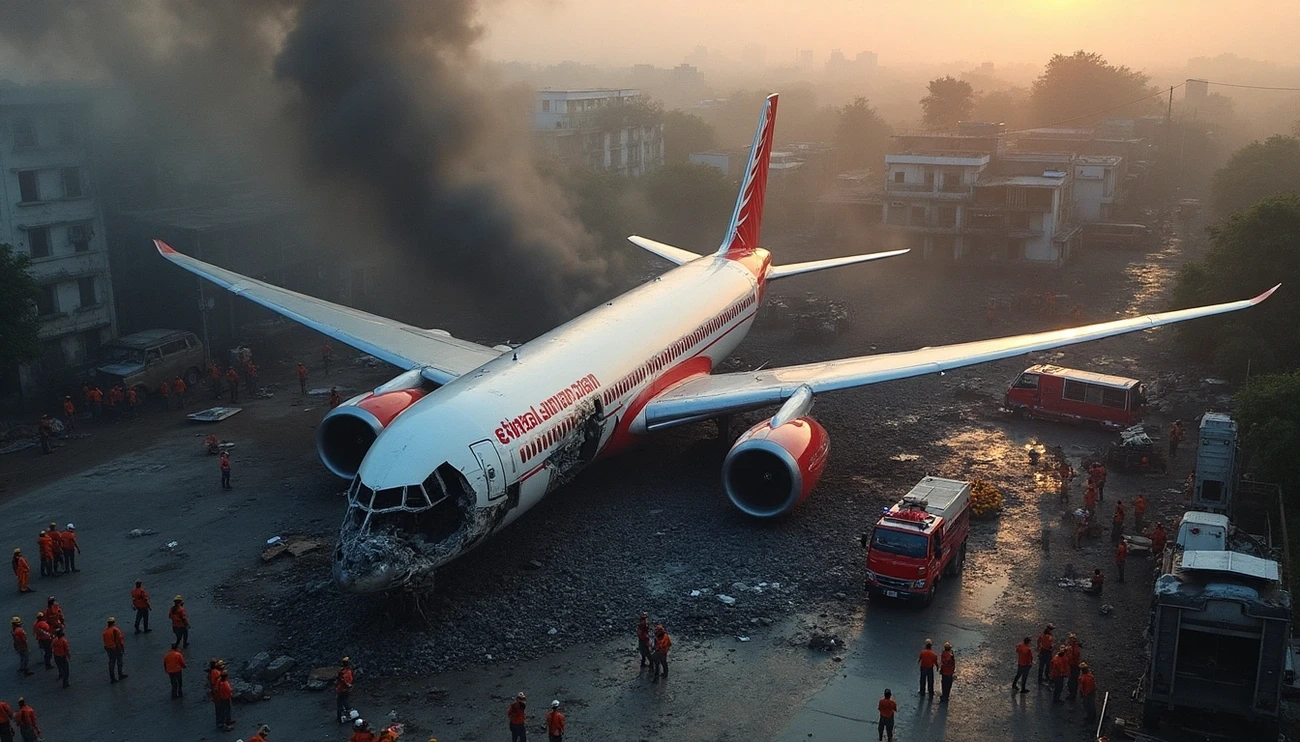Breaking: What Really Caused the Most Recent Plane Crash in Ahmedabad?
An Air India flight crashed less than 60 seconds after takeoff from Ahmedabad airport on Thursday, June 12, 2025, killing 241 of the 242 people on board. The Boeing 787-8 Dreamliner, bound for London's Gatwick Airport, plunged into a residential area called Meghani Nagar.
Flight AI171 departed at 13:39 local time (08:09 GMT) and was scheduled to land at London Gatwick at 18:25 BST. At least 8 people on the ground were killed when the aircraft struck a medical college hostel during lunch hour, including 4 medical students.
Moments after takeoff, the plane issued a Mayday distress call to air traffic control before contact was lost. Flight tracking data shows the aircraft reached a maximum altitude of just 625 feet before beginning its fatal descent.
The crash marked the first fatal accident for the Dreamliner since the wide-body jet began flying commercially in 2011. The 11-year-old aircraft had completed more than 700 flights in the year before Thursday's accident.
British national Vishwashkumar Ramesh, seated in 11A next to an emergency exit, survived the crash. "I still cannot believe how I made it out alive," Ramesh told India's state broadcaster. "At first, I thought I was going to die. I managed to open my eyes, unfastened my seat belt and tried to exit the plane".
India's Aircraft Accident Investigation Bureau recovered the flight data recorder within 28 hours. Investigators from India, the UK, and the US have arrived to examine the accident.
The investigation is examining several potential causes, including engine thrust issues, flap problems, and why the landing gear remained deployed during takeoff. Boeing CEO Kelly Ortberg said the company is supporting the investigation.
Flight AI171 was carrying 242 people when it crashed into the BJ Medical College hostel building about 2km from the airport.
Timeline of the crash: what happened in those 60 seconds

Image Source: Yahoo
Flight AI171's final moments unfolded with devastating speed on Thursday afternoon. The Boeing 787 Dreamliner completed its pushback at 1:30 PM before lining up on Runway 28 for takeoff.
Takeoff and initial climb
The aircraft began its takeoff roll at 1:38:24 PM, lifting off from runway 23 at Sardar Vallabhbhai Patel International Airport 16 seconds later. The plane climbed normally for only a brief moment, reaching a maximum altitude of just 625 feet and a top speed of 174 knots.
Captain Sumeet Sabharwal issued a "Mayday" distress call to air traffic control less than a minute after takeoff. Controllers received no response when they attempted to communicate with the aircraft.
Sudden descent and impact
The Dreamliner began its fatal descent within 33 seconds of takeoff. Witnesses observed the plane descending with its nose pitched upward and landing gear still extended—both highly unusual configurations for this phase of flight.
At 1:39:13 PM, the aircraft entered a shallow descent before erupting into a massive fireball. The 227-ton plane slammed into the hostel building of BJ Medical College about 2km from the airport.
Eyewitness accounts and survivor's story
"When we stepped out, we saw thick smoke in the air," said one witness who rushed to the scene after hearing the impact. Another described seeing "bodyan bahot saari padi hain" (so many dead bodies) scattered among the wreckage.
Survivor Vishwash Kumar Ramesh, who occupied seat 11A, described the final moments from his hospital bed. "I don't know how I came out alive," he said. "When the flight took off, within five to 10 seconds it felt like it was stuck in the air... The aircraft wasn't gaining altitude and was just gliding before it suddenly slammed into a building".
The crash has prompted aviation experts worldwide to examine the sequence of events that led to the disaster.
Aviation experts examine potential causes
Aviation experts are examining several theories about what caused the Air India flight to crash within 60 seconds of takeoff.
Engine thrust problems
The cockpit's final transmission revealed a critical situation: "Thrust not achieved... falling... Mayday! Mayday! Mayday!". The distress call suggests both engines may have lost power simultaneously—an occurrence estimated at "one in a billion cases".
"It does look to me like a significant loss of thrust. Thrust effectively makes you go faster, and aircraft lift is proportional to speed squared," said Dr. Sonya Brown, an aerospace design expert.
Aircraft configuration issues
Several analysts noted problems with the plane's setup during takeoff:
Aviation analyst Geoffrey Thomas observed: "The undercarriage is still down but the flaps have been retracted". Expert Terry Tozer added: "It doesn't look as if the flaps are extended and that would be a perfectly obvious explanation for an aircraft not completing its take-off correctly".
Boeing safety consultant Anthony Brickhouse highlighted another concern: "One problematic sign from videos of the aircraft was that the landing gear was down at a phase of flight when it would typically be up".
Bird strikes
Ahmedabad airport reported 38 bird strikes in 2022-23, a 35% increase from the previous year. Gujarat state documented 462 bird strike incidents over five years, with most occurring at Ahmedabad airport.
Mechanical system failures
University professor Ahmed Busnaina suggested throttle problems: "It could also be a throttle system failure. Many of these new airplanes have an automatic throttle; so there could have been some kind of malfunction there". Fuel contamination could also explain why both engines lost power nearly simultaneously.
Crew experience vs technical failure
Former pilot Neil Hansford defended the crew's capabilities: "The captain and first officer were very experienced. This is a superior plane, we're not talking about a cowboy airline here".
The investigation now focuses on determining whether the crash resulted from mechanical failure or other factors.
Boeing 787 Dreamliner had operated 14 years without fatal accident

Image Source: The Economic Times
The Boeing 787 Dreamliner had operated for 14 years without a single fatal incident before Thursday's crash in Ahmedabad. The wide-body aircraft has carried more than 1 billion passengers since beginning commercial service in 2011.
Currently, 1,148 Dreamliners operate globally with an average fleet age of 7.5 years. The aircraft opened 425 new nonstop routes worldwide since its introduction.
"It's shocking that there was a catastrophic incident on a plane with qualified crew and extensive experience in flying hours and maintenance," said Mark D Martin, Member of the Royal Aeronautical Society UK.
The Dreamliner faced significant challenges early in its service life. Battery fires in Japan prompted worldwide grounding of all 787s in January 2013. Operations resumed in April 2013 after Boeing implemented battery system modifications.
Between 2019 and 2024, multiple whistleblowers raised concerns about manufacturing practices. Deliveries were paused for over a year during 2021-2022 due to quality concerns about paper-thin gaps in the fuselage.
Air India's experience with the Dreamliner has been particularly troubled. The airline reported 136 technical problems with its Dreamliner fleet by late 2013. Between 2015 and 2024, Air India's 787 flights reported 32 incidents involving engine shutdowns, flight control glitches, and cabin pressure issues.
The aircraft that crashed on Thursday was delivered to Air India in January 2014, making it 11 years old. It had accumulated over 41,000 flight hours and completed almost 8,000 takeoffs and landings. The plane performed approximately 700 flight cycles in the 12 months before the crash.
This aircraft belonged to Air India's early-production 787s that were heavier than later models due to custom-fitted reinforcements. The aircraft underwent enhanced safety inspections as mandated by the DGCA, particularly regarding its GEnx engines.
Investigators begin examining Air India crash wreckage

Image Source: The Indian Express
Authorities recovered one of the aircraft's black boxes from the roof of the hostel mess building at B.J. Medical College on Friday, June 13. The device will provide crucial information about the final moments before the crash.
Investigators are searching for the second black box. Aircraft accident investigations typically rely on both the Cockpit Voice Recorder, which captures radio transmissions and cockpit conversations, and the Flight Data Recorder, which logs over 80 parameters including altitude, airspeed, and autopilot status.
"I think these are going to unlock the mystery of this accident, so it's critical to get these black boxes and get them read out," said former NTSB chairman Robert Sumwalt.
The Aircraft Accident Investigation Bureau, an independent division of India's Ministry of Civil Aviation, leads the investigation. The AAIB has [handled over 150 accident investigations](https://en.wikipedia.org/wiki/Aircraft_Accident_Investigation_Bureau_(India) and has immediate access to all evidence without seeking prior consent from judicial bodies. The bureau typically issues reports within three months.
Civil Aviation Minister Ram Mohan Naidu said the flight data recorder recovery "marks an important step forward in the investigation" and "will significantly aid the inquiry into the incident".
Indian authorities are considering grounding all Boeing Dreamliner 787-8 aircraft for safety reviews, though no decision has been finalized. The aviation regulator has ordered additional maintenance checks on Air India's Boeing 787-8/9 aircraft with GEnx engines, assessments of takeoff parameters and electronic engine control tests, and engine fuel-related checks across the fleet.
The US National Transportation Safety Board has sent investigators to assist, while the UK air accident investigation agency dispatched specialists. Engine manufacturer GE Aerospace deployed technical teams, and Boeing offered "full support" to both Air India and investigators.
"The 787 has very extensive flight data monitoring—the parameters on the flight data recorder are in the thousands—so once we get that recorder, they'll be able to know pretty quickly what happened," said aviation consultant John M. Cox.
The Ahmedabad crash represents the first fatal accident for the Dreamliner since the aircraft entered commercial service in 2011. The Boeing 787 had carried more than 1 billion passengers without a fatality before Thursday's accident.
Flight AI171's investigation has broader implications for the aviation industry. The crash occurred at a critical time for India's aviation sector, which recently became the world's fastest-growing air travel market. Passenger numbers are projected to reach 500 million annually by 2030, according to industry forecasts.
"Aviation accidents rarely happen because of a single failure," said aviation safety expert Captain Mohan Ranganathan. "They're usually the result of a chain of events where multiple safeguards break down simultaneously."
Air India announced interim compensation of ₹10 lakh ($12,000) per passenger. Final settlements could reach $175,000 under international aviation conventions. Families of victims have gathered at a support center established in Ahmedabad.
The accident marks Air India's worst disaster since the 1985 Kanishka bombing that killed 329 people. Commercial aviation had achieved its safest decade before this incident, with a global fatal accident rate of 0.20 per million flights.
Indian authorities have ordered additional safety checks on Air India's Boeing 787 fleet. The aviation regulator is considering whether to ground all Dreamliner aircraft pending the investigation results.
The Aircraft Accident Investigation Bureau aims to complete its preliminary report within three months. The US National Transportation Safety Board and UK air accident investigators are assisting with the probe.
Boeing faces scrutiny over manufacturing practices following years of quality concerns about the Dreamliner. The company suspended deliveries for over a year between 2021-2022 due to production issues.
Investigators must determine whether the crash resulted from mechanical failure, human error, or other factors. The flight data recorder analysis will likely provide crucial evidence about what caused the aircraft to lose control shortly after takeoff.
FAQs
Q1. What caused the Air India plane crash in Ahmedabad?
The exact cause is still under investigation. Preliminary reports suggest potential issues such as engine failure, flap malfunction, or a bird strike. The flight data recorder recovery will provide crucial information to determine the cause.
Q2. How many casualties were there in the Ahmedabad plane crash?
The crash resulted in 249 total casualties. This includes 241 of the 242 people on board the aircraft and at least 8 people on the ground, including 4 medical students.
Q3. What type of aircraft was involved in the crash?
The aircraft involved was a Boeing 787-8 Dreamliner. This was the first fatal crash for the Dreamliner model since it began commercial operations in 2011.
Q4. How are authorities investigating the crash?
India's Aircraft Accident Investigation Bureau is leading the investigation, with assistance from international agencies. They have recovered one black box and are analyzing flight data. Experts from the US, UK, and the aircraft manufacturer are also involved in the investigation.
Q5. What immediate actions have been taken following the crash?
Indian authorities have ordered additional safety checks on Air India's Boeing 787 fleet. They are considering grounding all Dreamliner aircraft for comprehensive safety reviews. Air India has also announced interim compensation for the victims' families.









